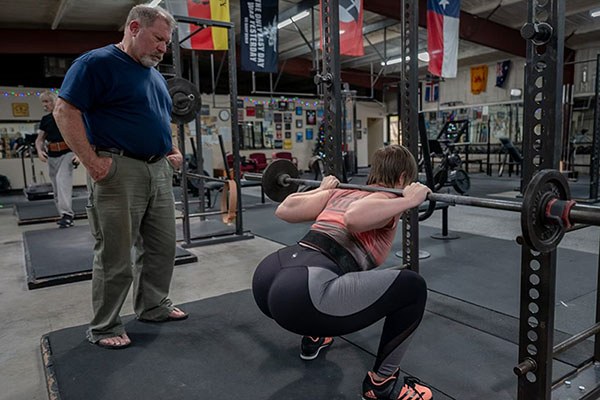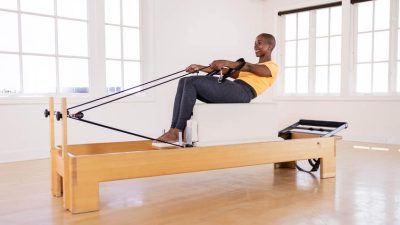
The majority of the world’s organized activities are predicated on
history. They do it “that way” because “That’s the way it’s
always been done, and it works for me.” The Baptist Church, the
treatment of skin rashes, frying chicken, plumbing in the UK, the
Marine Corps, building houses, cleaning cast iron pans, and strength
training proceed from what has always been done instead of what logic
and analysis would require.
We have attempted to
make Starting Strength different. I thought I’d take this time to lay
out the details of the logic behind the method.
Definitions
Starting Strength is a
strength training
method – nothing more, nothing less. It is not bodybuilding, it is
not about razor abz, or “muscularity” or “separation” or
“vascularity” or thin skin or handsomeness. It is about strength,
not appearance, and that is all. Muscles get stronger by growing
larger, and bigger muscles look better to other people, so Starting
Strength makes you look better – accidentally, because its
purpose is only strength. And strength is very easy to
understand: it is the ability to apply force against an external
resistance.
Force is the
quantity which causes a physical object to accelerate, to
change velocity. Velocity is the rate of change of an object’s
position in space. It can be quantified as meters per second, miles
per hour, or any other units of distance and time. If the object
slows down, that is negative acceleration, or deceleration. If
a change in an object’s motion – in either velocity or
direction – is observed, anywhere in the universe, force has been
applied to it.
The human body applies
force to its external environment through the mechanisms that operate
the system of levers that collectively are termed the musculoskeletal
system. The muscles get shorter under the coordinated control of
the system of motor neurons, and the contracting muscles move the
skeletal levers which apply force to the external resistances
encountered in the physical environment. Your voluntary physical
interaction – your movement within the environment – is a
function of musculoskeletal force production under the control of the
neuromuscular system.
In other words, your
entire physical existence is predicated on strength, whether you like
that or not. If you move an object, force was produced. If the object
moved is you, force was produced. The fact that you have a
physical body means that strength is the critical part of your
physical existence. Strength is merely one of the differences between
you and your grandmother, but it is the most important physical
difference.
Since strength is the
ability to produce force, it is measured in units of force
– pounds. Kilos are units of mass, and are less useful for
this task despite what Europeans believe. So an increase in strength
is simply the ability to lift heavier weights. A man with a
200 deadlift is not as strong as a woman with a 400 deadlift.
An improvement in
strength – in your ability to produce increased amounts of force –
improves your ability to interact with your physical environment. The
stronger you are the less likely you are to be unable to produce
sufficient force to interact at whatever level of intensity is
required by the situation at hand. It is indeed fortunate that
billions of years of vertebrate evolution has equipped us to adapt to
changes in our environment that challenge our fitness to survive in
it. Our DNA enables changes in the proteins we use to stay alive, and
thus adaptation to changes in the environment – temperature,
moisture, food availability, wound healing, and force production
requirements – are variables that must be adapted to for continued
physical existence.
And since the weights
we lift are part of the environment, they can be adapted to if the
approach to that adaptation is taken carefully and correctly.
Homeostasis is the
condition in which an organism is adapted to the current
environmental conditions. Any change in the environment that produces
stress sufficient to challenge its ability to continue to operate
within that environment will drive an adaptation toward homeostasis,
if the change is within the organism’s capacity for
adaptation. If you put a fish into a volcano, the fish dies
instantly, but if you merely warm the water 5 degrees, the fish can
adapt to the environmental change.
The
Problem
If
we are trying to force a strength adaptation, we carefully and
correctly change the environment with a loaded barbell. A strength
adaptation requires exposure to an increasingly heavy load, since a
strength increase means the ability to lift heavier weights in a
normal human movement pattern. In this context, carefully
means an increase in load that is appropriate to the adaptive
capacity of the organism – the human body cannot adapt to a
50-pound increase in load without altering the movement pattern, but
it can adapt to 5-pound or 2-pound increases for a long time. This is
why barbells work very well for strength training, and big rocks,
anvils, medicine balls, kettlebells, squeezy springs, and Nautilus
machines do not.
And correctly
means that the application of the increased load must consider the
musculoskeletal anatomy affected by the load, and must utilize that
anatomy efficiently and effectively. The correct approach to
increased strength must take into consideration the normal human
movement patterns that will be used to apply that force within the
environment. The movements must be bilateral, using both feet
and both arms at the same time, so that the entire body comprises the
kinetic chain of the movement pattern and so that heavy weights can
be lifted. (The bench press is bilateral in that the feet are used to
evenly brace the chest position, even though technically they are not
part of the kinetic chain of the movement.) Chin-ups are the
exception to this, and they are treated as an assistance exercise
that is added after several weeks of uninterrupted progress on the
barbell exercises.
The question, “How
much stronger are you now?” must be answerable – in pounds. If
your deadlift goes up 100 pounds, that’s a good answer. “Well, I
think I’m more comfortable now on this Bosu ball with a 20-pound
dumbbell” is not an answer. Force production is measured in
pounds, so increases in strength are also measured in pounds.
Solving
the problem
The exercises used in
Starting Strength are the squat (squatting down and standing back
up), the deadlift (picking something up off of the ground), the press
(pushing something up overhead), the bench press (pushing something
away from you), the power clean (throwing something up and catching
it), and chins and barbell rows (pulling something towards you).
These cover all the basic bilateral human movement patterns that can
be trained incrementally and progressively.
There are obviously
various ways to perform each of these basic exercises, but we’re
trying to lift the most weight possible in each exercise, so correct
technique is defined as the
movement pattern that 1.) involves the most muscle mass 2.) over the
longest efficient range of motion 3.) to enable the use of the
heaviest weights
4.) in order to most effectively increase strength. These techniques
are analyzable and discoverable, and the Blue Book details the form
for each exercise that satisfies these four criteria. `
The bilateral nature of
these movements is very important, because if
the whole body is strengthened, the increased strength enables
subsets of the whole body to function at increased levels of force production too. If my deadlift goes from 200 to 400, my
ability to pick up a heavier dumbbell with one hand increases at the
same time – without picking up any dumbbells. And dumbbell benches
are potentially dangerous because of the instability. If my squat
goes from 250 to 475, my ability to apply force unilaterally, like in
a dumbbell lunge, increases without doing any lunges. And heavy
dumbbell lunges are potentially dangerous due to the instability.
The
bilateral nature of barbell training is a feature, not a bug.
Stability is generated by the bilateral symmetry, and strength can
improve far more quickly and safely if the movement pattern is
inherently stable and heavier loads can be progressively applied. If
my bench, press, and chins go up in load, everything I can do with
one hand goes up too. And if your strength goes up, you’ll also be
more comfortable in an unstable position with a 20-pound dumbbell
without having to embarrass yourself by doing it in public.
The
Bottom Line
If I split the body
into smaller pieces, I cannot use as much weight as I can when the
whole body is used at the same time, and strength is only
increased and measured by the increase in the weight you lift. A
dumbbell split squat cannot make you stronger, because it is not
heavy enough to challenge your current level of strength unless you
have just not been training. But if your deadlift goes up, your whole
body gets stronger, and we know how to make your deadlift go up –
you just add 5 pounds per workout. It really is that simple, and this
obvious fact is completely ignored by the current fad known as
“functional training.”
All of the barbell
exercises use sets of 5 reps because 5s work better for building
strength – and therefore size – than any other approach, as
decades of experience has shown. Singles are too heavy to accumulate
sufficient total tonnage under the bar within a
workout, and do not allow for enough technique practice. Higher reps
– 8 or more – uses too light a weight to produce the intensity
necessary for a strength adaptation, and the fatigue that accompanies
high reps predisposes to technique errors at the end of the set. The
sweet spot is 5 reps, and entire lifting careers have been built on
5s for decades.
All the exercises are
performed for 3 sets of 5 across (using the same weight), with the
exception of the deadlift which uses only one heavy set. Again,
experience guides these numbers, and if you don’t believe them you
are hereby invited to sidetrack yourself and rediscover the rules,
again.
The programming is also
very simple, designed to gradually and incrementally accumulate a
force production adaptation. For deadlifts and squats, the first 4-5
workouts increase 10 pounds on the work sets, and then go back to
5-pound jumps for several months of uninterrupted progress. The
pressing exercises limited by smaller amounts of muscle mass start
with 5-pound increases and then drop back to 2-3 pound jumps. The
entire purpose of the first few months of training is to increase the
weight on the bar every workout. If
the weight goes up, force production has gone up, and therefore
strength has improved. And if the weight can
go up every workout, anything
else is wasting time.
The
important thing to understand here is that there is a logical way to
approach the problem, just like there is a logical way to approach
every problem. First, define the problem: you need to be stronger
than you are now. Second, what is Strength? Strength is the
production of force against resistance. Third, what does being
stronger require? The production of more force, i.e. lifting heavier
weights.
Finally,
what is the most efficient and effective way to do this? Loaded basic
human movement patterns using incrementally progressive loads on a
barbell over a long period of time. Execute the movement patterns
correctly, take appropriate increases in load on the bar, eat and
sleep well enough to manage recovery from the stress, and don’t miss
workouts.
And
that is all: no running, no “assistance exercises,” no extra
sets, no sets to failure, no situps, no back extensions, no
unnecessary stretching. Calculate your next workout based on the one
you just did, follow the pattern, lift the weights you’re supposed to
lift, and repeat this process until it stops working after several
months of steady progress. After that it gets a little more
complicated, but not much.
Most
problems are not as complicated as some people would like them to be.
Complexity sells, and you can usually buy it if you want to. But
complexity for its own sake is just a business model, and has very
little to do with training, as you can see.






